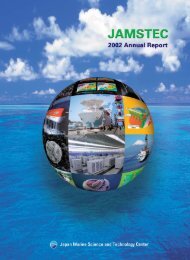2007 Annual Report - jamstec japan agency for marine-earth ...
2007 Annual Report - jamstec japan agency for marine-earth ...
2007 Annual Report - jamstec japan agency for marine-earth ...
Create successful ePaper yourself
Turn your PDF publications into a flip-book with our unique Google optimized e-Paper software.
Ocean around Nov. 2005, more than 9 months be<strong>for</strong>e the<br />
appearance of the IOD event Fig.1, and subsequent eastward<br />
propagation of the upwelling Kelvin waves along the<br />
equator, showing the importance of the ocean dynamics <strong>for</strong> the<br />
IOD predictability.<br />
In <strong>2007</strong>, the positive IOD event occurred again in the tropical<br />
Indian Ocean, generating the first consecutive positive IOD<br />
years ever since early 1950's, when the recent comprehensive<br />
observations started to take place. At the same time, La Nina<br />
phenomenon appeared in the Pacific Ocean, which provided<br />
quite rare condition with positive IOD in the Indian Ocean, 40<br />
years after the previous event of the same situations in the tropical<br />
Indo-Pacific sector in 1967.<br />
Figure2 indicates horizontal distribution of the SSTA averaged<br />
over three months during Sep. to Nov. <strong>2007</strong>, predicted<br />
from Apr. <strong>2007</strong> as the initial condition <strong>for</strong> the SINTEX-F<br />
CGCM <strong>for</strong>ecast experiment. The typical SSTA pattern of the<br />
positive IOD event can be seen in the tropical Indian Ocean,<br />
while the eastern equatorial Pacific demonstrate large negative<br />
SSTA associated with strong La Nina event. Successful prediction<br />
of the both climate events in the two basins suggests the<br />
significant per<strong>for</strong>mance of SINTEX-F model in reproducing not<br />
only the climate modes themselves but also the climatological<br />
seasonal cycle as basic states <strong>for</strong> these climate modes.<br />
Most of the results were published in major scientific journals,<br />
and the press release on the <strong>2007</strong> IOD prediction caught<br />
strong attention of public. We will continue the study on the<br />
processes affecting the ENSO/IOD predictability and will try to<br />
enhance our contribution to disaster prevention activities in the<br />
regions surrounding the Indian Ocean, through improving the<br />
prediction skills of the short-term climate variability over Indo-<br />
Pacific sector.<br />
b. Studies on oceanic variability based on the OFES simulation<br />
Collaborating with the Earth Simulator Center, we have<br />
conducted very high resolution ocean simulations using the<br />
Ocean GCM <strong>for</strong> the Earth Simulator OFES. Those are<br />
highly valuable to improve our understanding of various spatiotemporal<br />
oceanic variations not only in the surface layer, which<br />
interact with the atmosphere directly, but also those in the subsurface<br />
ocean interiors. In our program, we investigate oceanic<br />
variability from extensive viewpoints: behaviors of eddies, their<br />
impacts on large-scale ocean circulation, global ocean energy<br />
balance, and so on. Meanwhile, here a particular study on<br />
decadal variability in the Pacific Ocean is reported.<br />
For decadal variability in the tropical Pacific Ocean, many<br />
hypotheses have been proposed. One of them suggests that<br />
oceanic temperature anomalies subduct into the subsurface<br />
layer in the subtropics, move equatorward, and surface there to<br />
induce equatorial SST anomalies. For the North Pacific Ocean,<br />
this has been denied. On the contrary, in the South Pacific, such<br />
equatorward temperature anomaly propagation has been found<br />
in observation, ocean GCMs, and a coupled GCM.<br />
Interestingly, cool warm subsurface temperature anomalies<br />
tend to be <strong>for</strong>med when SSTs have warm cool anomalies;<br />
their <strong>for</strong>mation mechanism is not intuitive and was not understood.<br />
While importance of diapycnal mixing at the bottom of<br />
the surface mixed layer was suggested recently, Nonaka and<br />
Sasaki <strong>2007</strong>, J. Climate gave a simple explanation <strong>for</strong> this<br />
counter-intuitive temperature anomaly <strong>for</strong>mation by paying<br />
attention to large meridional migration of outcrop line of isopycnal<br />
surfaces along which the temperature anomalies subduct.<br />
Figure3 shows that subsurface temperature anomalies<br />
propagate from the southeastern subtropical South Pacific to the<br />
western boundary region panel b, and further extend to the<br />
equatorial region panel a. On the one hand, in the <strong>for</strong>mation<br />
region of the anomalies, warm cool anomalies tend to<br />
be <strong>for</strong>med panels b and c when the latitudes where the<br />
isopycnal surface that the anomalies sudbuct intersects with the<br />
sea surface migrates equatorward poleward, as warm<br />
Fig.2 Predicted sea surface temperature anomaly SSTA during<br />
Sep./Oct./Nov. <strong>2007</strong>, starting from Apr. 1st, <strong>2007</strong>. Typical SSTA patterns<br />
of the positive IOD event and La Nina phenomenon can be seen in<br />
the tropical Indian Ocean and Pacific Ocean, respectively.<br />
cool water exists in lower latitudes. On the other hand, the<br />
outcrop latitudes tend to migrate equatorward poleward
















